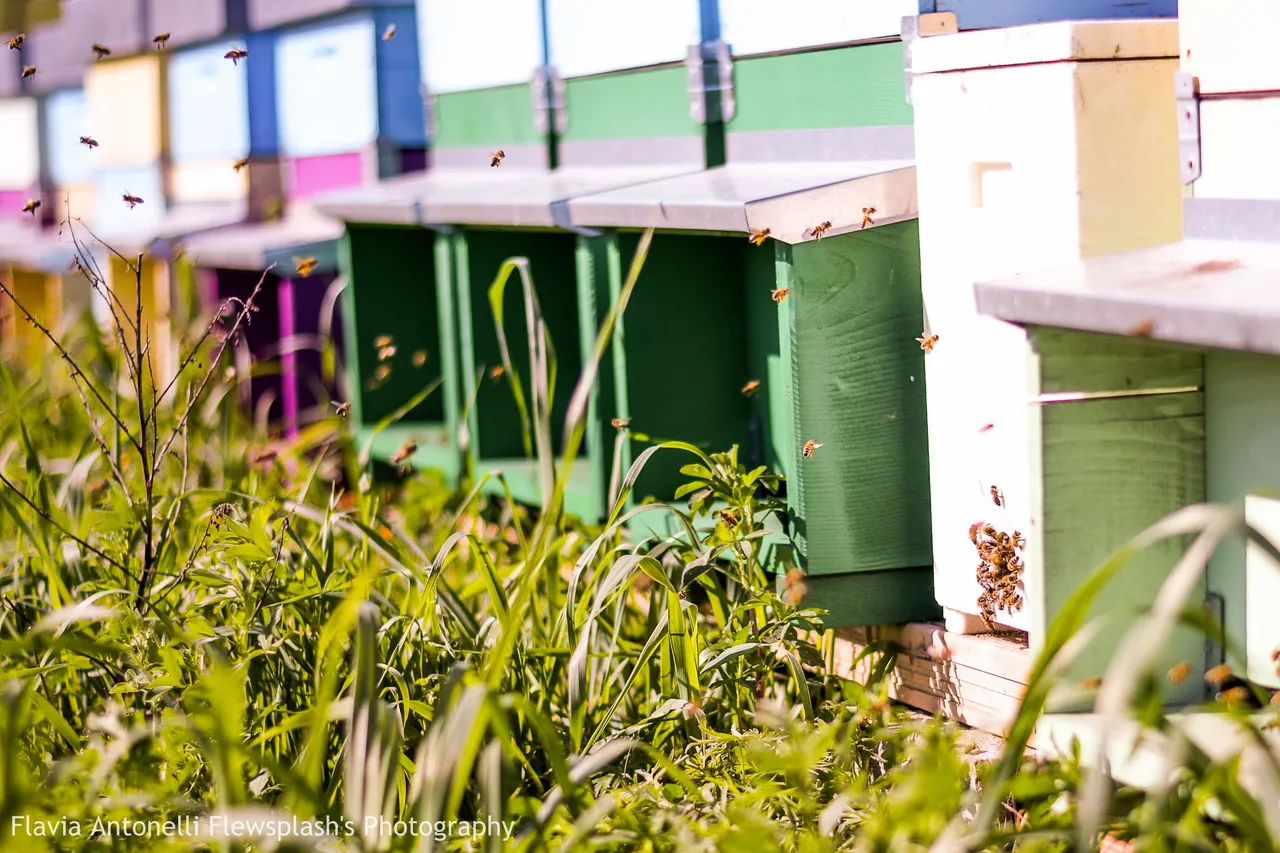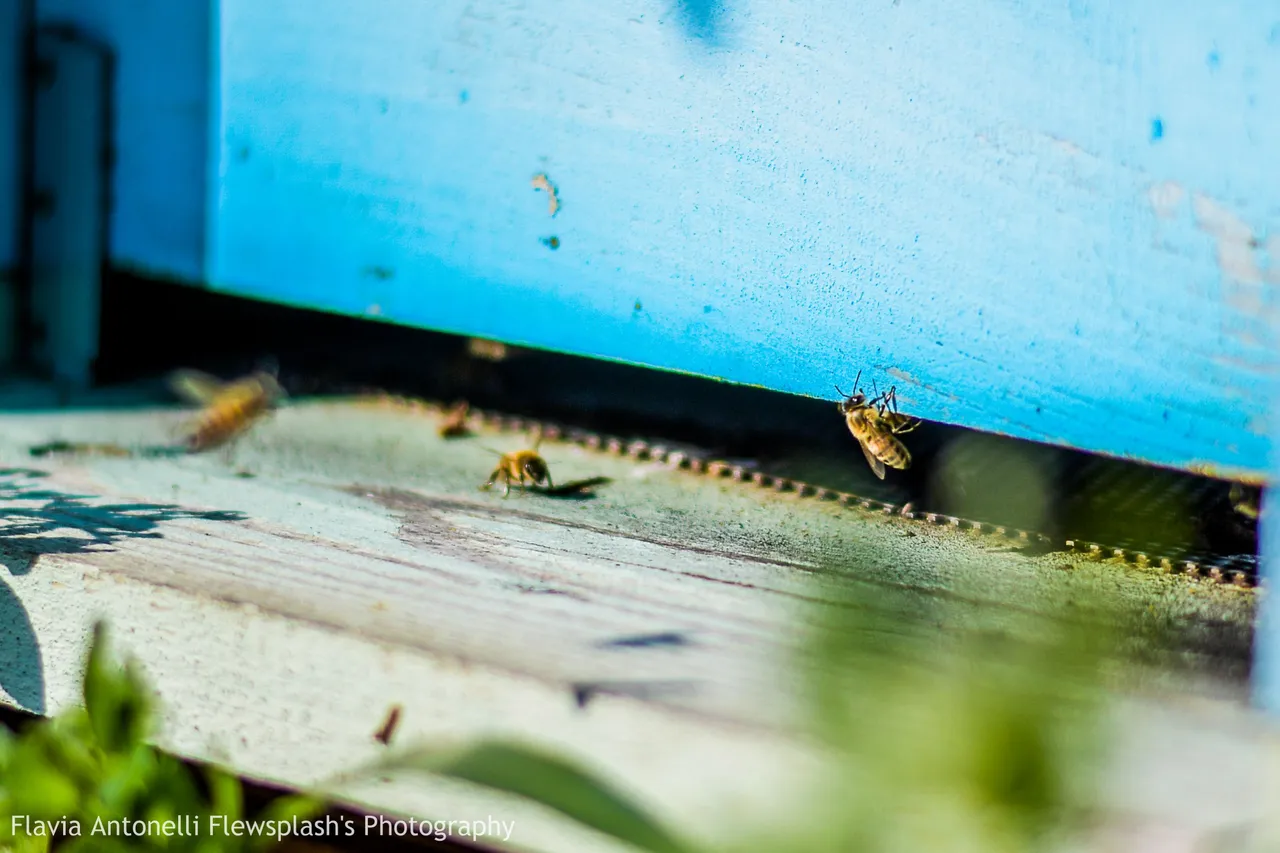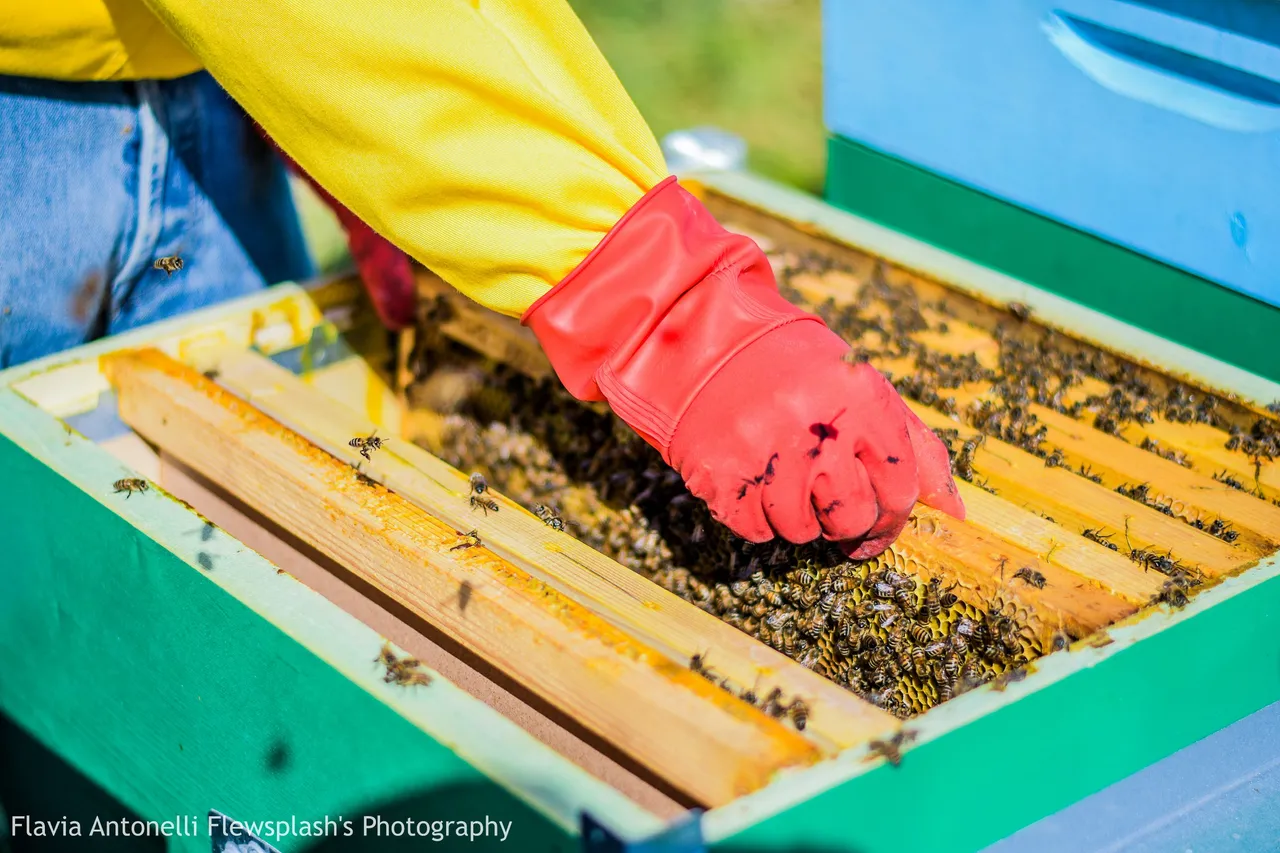Easter in Italy is a special day, but above all a day in which you EAT A LOT, with your family, with relatives, with friends. Given the period of restrictions due to the pandemic, I and my partner celebrated in a quiet way: an (infinite) lunch with many courses at his parents' house. As I write this post I'm still digesting, but dedicating myself to my passion for photography has helped me in the heavy post-lunch phase.
Today I focused on the post-production of a series of shots that date back to March 30, so last week. I went on a mission with my Nikon D500 to do some photoreporting at @phage93's work.
It was a spectacular day, a crazy sunny Tuesday, warm temperature being Spring, not a single cloud in the sky.
@phage93 and I drove to the field where he has his hives and where he works as a real professional beekeeper. For me it was the first time, I had never seen a hive or been in the midst of a swarm of more than 50,000 bees. A unique experience!






Once at the place, he began to explain a few things to me: each family has only one queen bee, the other bees are for the most part females, the worker bees. The latter are those who work, making honey from the nectar of the blooms, bringing it into the hives, and feeding the queen and the drones, the males. Instead, these are only active in the act of fertilizing the queen. In winter, when the activity of bees is lower because there are fewer blooms, the worker bees stop feeding the males, which then die. Unlike worker bees, the queen bee practically never leaves the hive.
On average, the life of a bee is about 30 days. In winter, however, they can live up to 60 days; in fact the duration of their life is directly proportional to the quantity of activities they carry out.









Each bee perfectly knows its own hive to which it returns every time. The bees are not active at night, and hide in their houses, as well as when there is bad weather and it rains. In fact, water drops are to bees like asteroids, water bombs that would land them, preventing them from flying. Bees never stray far from their hives, so it's important for a beekeeper to place their bees in a place where there is enough flowering. From the chemical analyzes of honey produced by bees, it is possible to understand where they got the nectar from, or from which blooms that particular honey comes. Clearly the flavor of honey can depend on various factors, but its purity depends above all on the action of the beekeeper, or on how much water he adds to the natural process of action of the bees, and on any posthumous manipulation of the honey itself that the bees have made.
@phage93 is extremely professional and does his best to raise the level of the quality of his honey more and more. Some of the hives he owns are actually for sale: in fact, in addition to producing and selling honey, @phage93 sells the hives too. In particular, he explained to me that those that he owns to sell in a short period, in Spring that has just begun, are underdeveloped, which is why he tries to speed up the process by adding the solution of water and sugar into the hives; this action facilitates the bees in the production of honey. In fact, both water and sugar are the substances that bees naturally take from the vegetation around the hive.











Now an interesting side story: as a child, I must have been about 8 years old, on a Summer day, while I was on the beach, a bee touched my right eye. Touched! After about ten minutes my whole face was completely swollen: my mother took me to the hospital and I was "saved". Now, this story was the first thing I told @phage93 when we got there. So, just for his information 😅 Clearly, when you're in the middle of a swarm, you don't go away so easily! In fact, the suit made specifically for this activities was the first thing he lent me: it was a whole, from head to ankles. No part of the body was exposed, not even the hands, which I clearly covered with a pair of latex gloves. I admit that handling the camera and work with the focus were two extremely complex activities, considering the gloves and the helmet net. Really complicated! But I hope I did a good job, I am personally very satisfied because I had never been tested in a context of this kind. Shooting mostly macro and having various obstacles in doing so is really challenging, but I also had a lot of fun, as I was also learning a lot of new things.







I hope to have more opportunities to learn more about the world of bees thanks to @phage93. In case you didn't know, he has launched a campaign called "Adopt a hive" thanks to which everyone, with a negligible expense, can remotely adopt a hive and support his work as a beekeeper. What will you get in return? Photos and detailed updates of your bees and their honey produced at the end of the year: an initiative of a unique sweetness, in the true sense of the word!
Equipment:
- Nikon D500
- Nikkor Lens 50mm
Post-production: Lightroom
ITA
Thank you very much for reading this far, I hope you enjoyed the photos. Leave a comment with your opinion! I will be happy to answer you!
Yours | Flewsplash
Quale miglior modo di festeggiare la Pasqua se non facendo la cosa che più amo al mondo?!
La Pasqua in Italia è un giorno speciale, ma soprattutto un giorno in cui si MANGIA TANTO, in famiglia, con i parenti, con gli amici. Dato il periodo di restrizioni a causa della pandemia, io e il mio compagno abbiamo festeggiato in maniera tranquilla: un pranzo (infinito) con tantissime portate a casa dei suoi genitori. Mentre scrivo questo post sto ancora digerendo, ma dedicarmi alla mia passione per la fotografia mi ha aiutato nella fase post-pranzo pesante.
Quest'oggi mi sono concentrata sulla postproduzione di una serie di scatti che risalgono al 30 marzo, quindi la scorsa settimana. Sono andata in missione con la mia Nikon D500 a fare un po' di photoreporting al lavoro di @phage93.
Era una giornata spettacolare, un martedì di sole pazzesco, temperatura calda per essere primavera, non una nuvola in cielo.
@phage93 ed io ci siamo diretti al campo dove lui ha le sue arnie e dove lavora da vero apicoltore professionista. Per me era la prima volta, non avevo mai visto un'arnia né ero mai stata in mezzo ad uno sciame di più di 50 000 api. Un'esperienza unica!






Arrivati al posto, mi ha cominciato a spiegare un po' di cose: ogni famiglia ha una sola ape regina, le altre api sono per la maggior parte femmine, le api operaie. Queste ultime sono coloro che si occupano di lavorare, facendo il miele dal nettare delle fioriture portandolo nelle arnie, e nutrendo la regina e i fuchi, i maschi. Questi invece sono attivi solo nell'atto di fecondare la regina. D'inverno, quando l'attività delle api è minore perché ci sono meno fioriture, le api operaie smettono di nutrire i maschi, che quindi muoiono. A differenza delle api operaie, l'ape regina non esce praticamente mai dall'arnia.
In media, la vita di un'ape è di circa 30 giorni. D'inverno però possono arrivare a vivere anche fino a 60 giorni; infatti la durata della loro vita è direttamente proporzionale alla quantità di attività che svolgono.









Ogni ape conosce perfettamente la propria arnia a cui fa ritorno ogni volta. La notte le api non sono attive, e si rintanano dentro le loro casette, così come quando c'è maltempo e piove. Infatti le gocce d'acqua sono per le api come degli asteroidi, delle bombe d'acqua che le atterrerebbero, impedendo loro di volare. Le api non si allontanano mai molto dalla propria arnia, quindi è importante, per un apicoltore, posizionare le proprie api in un posto dove ci sia abbastanza fioritura. Dalle analisi chimiche del miele prodotto dalle api, si può capire da dove queste hanno preso il nettare, ovvero da quali fioriture proviene quel determinato miele. Chiaramente il sapore del miele può dipendere da vari fattori, ma la sua purezza dipende soprattutto dall'azione dell'apicoltore, ovvero da quanta acqua aggiunge al naturale processo di azione delle api, e da un'eventuale manipolazione postuma del miele stesso che le api hanno realizzato.
@phage93 è estremamente professionale e fa del suo meglio per alzare sempre di più l'asticella della qualità del suo miele. Alcune delle arnie che possiede sono in realtà in vendita: infatti, oltre a produrre e vendere miele, @phage93 mette in vendita le arnie. In particolare mi ha spiegato che quelle che deve vendere in un breve periodo, in primavera appena iniziata, sono poco sviluppate, motivo per cui cerca di accelerare il processo aggiungendo la soluzione di acqua e zucchero dentro le arnie; questa azione facilita le api nella produzione di miele. Infatti, sia l'acqua che lo zucchero sono le sostanze che le api, naturalmente, assumono dalla vegetazione nei dintorni dell'arnia.






<center<




Ora una side story interessante: da piccola, avrò avuto circa 8 anni, in una giornata d'estate, mentre ero in spiaggia, un'ape mi ha sfiorato l'occhio destro. Sfiorato! Dopo una decina di minuti avevo l'intera faccia completamente gonfia: mia madre mi ha portata all'ospedale e sono stata "salvata". Ora, questa storiella è stata la prima cosa che ho riferito a @phage93 quando siamo arrivati sul posto. Così, giusto per informazione 😅 Chiaramente, quando stai in mezzo ad uno sciame, non ci vai con leggerezza! Infatti la tuta fatta appositamente per questo è stata la prima cosa che mi ha prestato: era intera, dalla testa alle caviglie. Nessuna parte del corpo era scoperta, neanche le mani, che chiaramente ho coperto con un paio di guanti in lattice. Ammetto che maneggiare la macchina fotografica e mettere a fuoco erano due attività estremamente complesse, considerati i guanti e la retina del casco. Veramente complicato! Spero però di aver fatto un bel lavoro, sono personalmente molto soddisfatta perché non ero mai stata messa alla prova in un contesto di questo genere. Fotografare per lo più macro e avere vari ostacoli nel farlo è veramente sfidante, ma mi sono anche divertita molto, oltre al fatto che ho imparato veramente molte cose nuove.







Spero di avere altre occasioni per conoscere meglio il mondo delle api grazie a @phage93. Nel caso non lo sapeste, ha lanciato una campagna dal nome "Adotta un'arnia" grazie alla quale chiunque, con una spesa irrisoria, può adottare a distanza un'arnia e supportare il suo lavoro di apicoltore. Cosa avrete in cambio? Foto e aggiornamenti dettagliati delle vostre api e il loro miele prodotto a fine anno: un'iniziativa di una dolcezza unica, nel vero senso della parola!
Equipment:
- Nikon D500
- Nikkor Lente 50mm
Post-produzione: Lightroom
Grazie mille per aver letto fin qui, spero abbiate apprezzato le foto. Lasciate un commento con la vostra opinione! Sarò felice di rispondervi!
Yours | Flewsplash


































































